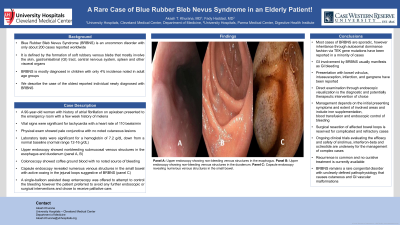Back


Poster Session E - Tuesday Afternoon
Category: GI Bleeding
E0313 - A Case of Blue Rubber Bleb Nevus Syndrome in an Elderly Patient
Tuesday, October 25, 2022
3:00 PM – 5:00 PM ET
Location: Crown Ballroom

Has Audio

Akash T. Khurana, MD
University Hospitals/CMC
Cleveland, OH
Presenting Author(s)
Fady G. Haddad, MD1, Akash Khurana, MD2
1University Hospitals Parma Medical Center, Parma, OH; 2University Hospitals of Cleveland, Cleveland, OH
Introduction: Blue Rubber Bleb Nevus Syndrome (BRBNS) is an uncommon disorder with only about 200 cases reported worldwide. It is defined by the formation of soft rubbery venous blebs that mostly involve the skin, gastrointestinal (GI) tract, central nervous system, spleen and other visceral organs. BRBNS is mostly diagnosed in children with only 4% incidence noted in adult age groups. Herein we describe the case of the oldest reported individual newly diagnosed with BRBNS who was a 90 year-old lady presenting with small bowel bleeding.
Case Description/Methods: A 90-year-old woman with history of atrial fibrillation on apixaban presented to the emergency room with a few week history of melena. Vital signs were significant for tachycardia with a heart rate of 110 beats/min. Physical exam showed pale conjunctiva with no noted cutaneous lesions. Laboratory tests were significant for a hemoglobin of 7.2 g/dL down from a normal baseline (normal range 12-16 g/dL). Upper endoscopy showed non bleeding submucosal venous structures in the esophagus and duodenum (panel A, B). Colonoscopy showed coffee ground blood with no noted source of bleeding. Capsule endoscopy revealed numerous venous structures in the small bowel with active oozing in the jejunal loops suggestive of BRBNS (panel C). A single-balloon assisted deep enteroscopy was offered to attempt to control the bleeding however the patient preferred to avoid any further endoscopic or surgical interventions and chose to receive palliative care.
Discussion: Most BRBNS cases are sporadic however inheritance through autosomal dominance fashion via TEK gene mutations have been reported in a minority of cases. GI involvement by BRBNS usually manifests as GI bleeding that can range from a chronic slow rate to a massive and life-threatening hemorrhage. Presentation with bowel volvulus, intussusception, infarction and gangrene have been reported. Direct examination through endoscopic visualization is the diagnostic and potentially therapeutic intervention of choice. Management depends on the initial presenting symptoms and extent of involved areas and include iron supplementation, blood transfusion and endoscopic control of bleeding. Surgical resection of affected bowel loops is reserved for complicated and refractory cases. Ongoing clinical trials evaluating the efficacy and safety of sirolimus, interferon-beta and octreotide are underway for the management of complex cases. Recurrence is common and no curative treatment is currently available.

Disclosures:
Fady G. Haddad, MD1, Akash Khurana, MD2. E0313 - A Case of Blue Rubber Bleb Nevus Syndrome in an Elderly Patient, ACG 2022 Annual Scientific Meeting Abstracts. Charlotte, NC: American College of Gastroenterology.
1University Hospitals Parma Medical Center, Parma, OH; 2University Hospitals of Cleveland, Cleveland, OH
Introduction: Blue Rubber Bleb Nevus Syndrome (BRBNS) is an uncommon disorder with only about 200 cases reported worldwide. It is defined by the formation of soft rubbery venous blebs that mostly involve the skin, gastrointestinal (GI) tract, central nervous system, spleen and other visceral organs. BRBNS is mostly diagnosed in children with only 4% incidence noted in adult age groups. Herein we describe the case of the oldest reported individual newly diagnosed with BRBNS who was a 90 year-old lady presenting with small bowel bleeding.
Case Description/Methods: A 90-year-old woman with history of atrial fibrillation on apixaban presented to the emergency room with a few week history of melena. Vital signs were significant for tachycardia with a heart rate of 110 beats/min. Physical exam showed pale conjunctiva with no noted cutaneous lesions. Laboratory tests were significant for a hemoglobin of 7.2 g/dL down from a normal baseline (normal range 12-16 g/dL). Upper endoscopy showed non bleeding submucosal venous structures in the esophagus and duodenum (panel A, B). Colonoscopy showed coffee ground blood with no noted source of bleeding. Capsule endoscopy revealed numerous venous structures in the small bowel with active oozing in the jejunal loops suggestive of BRBNS (panel C). A single-balloon assisted deep enteroscopy was offered to attempt to control the bleeding however the patient preferred to avoid any further endoscopic or surgical interventions and chose to receive palliative care.
Discussion: Most BRBNS cases are sporadic however inheritance through autosomal dominance fashion via TEK gene mutations have been reported in a minority of cases. GI involvement by BRBNS usually manifests as GI bleeding that can range from a chronic slow rate to a massive and life-threatening hemorrhage. Presentation with bowel volvulus, intussusception, infarction and gangrene have been reported. Direct examination through endoscopic visualization is the diagnostic and potentially therapeutic intervention of choice. Management depends on the initial presenting symptoms and extent of involved areas and include iron supplementation, blood transfusion and endoscopic control of bleeding. Surgical resection of affected bowel loops is reserved for complicated and refractory cases. Ongoing clinical trials evaluating the efficacy and safety of sirolimus, interferon-beta and octreotide are underway for the management of complex cases. Recurrence is common and no curative treatment is currently available.

Figure: Panel A: Upper endoscopy showing non-bleeding venous structures in the esophagus. Panel B: Upper endoscopy showing non-bleeding venous structures in the duodenum. Panel C: Capsule endoscopy revealing numerous venous structures in the small bowel.
Disclosures:
Fady Haddad indicated no relevant financial relationships.
Akash Khurana indicated no relevant financial relationships.
Fady G. Haddad, MD1, Akash Khurana, MD2. E0313 - A Case of Blue Rubber Bleb Nevus Syndrome in an Elderly Patient, ACG 2022 Annual Scientific Meeting Abstracts. Charlotte, NC: American College of Gastroenterology.
